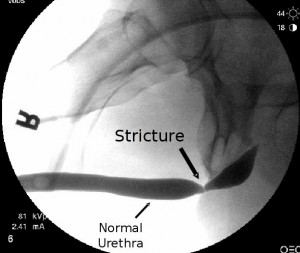by Rajveer S. Purohit, MD, MPH
A urethral stricture is a narrowing of the urethra caused by scar tissue but we often refer to the condition with the phrase urethral stricture disease. Sounds similar but a key difference is that last word “disease” and that goes a long way to explaining some of the critical ideas to understanding the nature of the problem. Urethral stricture disease refers not only to the narrowing of the lining of the urinary tube (the urethra) by scar tissue but refers to scar tissue that underlies the channel. To understand this better, imagine the urethral as a long tubular donut with the hole (the lumen) being where the urine is carried. The spongy part of the donut is called the corpus spongiosum (spongy body) and is a rich vascular network that carries oxygen and nutrients to the inner lining of the hole (the urethra) to keep it healthy.
 Urethral stricture disease, then, refers not only to scar tissue that closes the urethra, or a urethral stricture, but also refers to the presence of scar tissue in the corpus spongiosum, in a process called spongiofibrosis. Spongiofibrosis prevents vital nutrients and oxygen from getting to the urethra and keeping it healthy. Urethral stricture disease than is a urethral stricture with underlying spongiofibrosis.
Urethral stricture disease, then, refers not only to scar tissue that closes the urethra, or a urethral stricture, but also refers to the presence of scar tissue in the corpus spongiosum, in a process called spongiofibrosis. Spongiofibrosis prevents vital nutrients and oxygen from getting to the urethra and keeping it healthy. Urethral stricture disease than is a urethral stricture with underlying spongiofibrosis.
It is clear from this description why the failure rate for urethral dilation or urethrotomy (endoscopic incision into the urethral stricture) is high, particularly for those patients with dense, long strictures and extensive spongiofibrosis. If the donut hole is forcibly opened with a dilator or cut the underlying scar tissue, or spongiofibrosis, is still not corrected. Over time the absence of a healthy blood supply to the lining causes the stricture to recur. In fact, there is increasing data to suggest that every time you do a dilation or urethrotomy to open a stricture you can also cut into the delicate corpus spongiosum and cause further scar tissue or spongiofibrosis to form. This in turn makes recurrences after dilations more dense and often longer than the original.
Although there is a high failure rate after a urethral dilation, there is a role for it in some circumstances as we’ll discuss in a future blog post.

